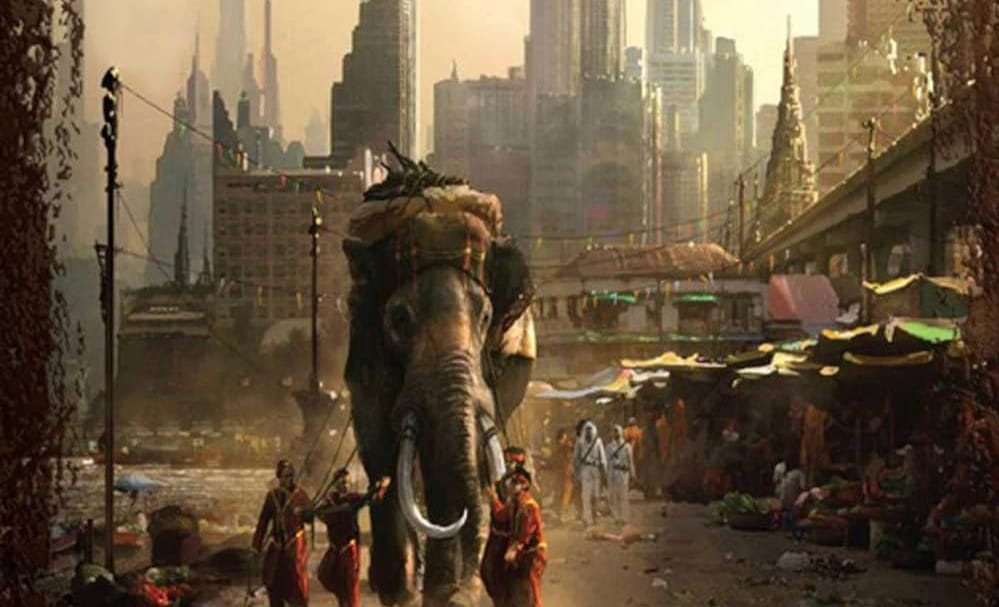Winding Back the Clock on The Windup Girl

In 2009, Paolo Bacigalupi erupted onto the science fiction main stage with The Windup Girl. He had begun publishing a decade before, releasing a handful of critically acclaimed short stories, earning a number of nominations for the Nebula and Hugo awards, and helping to propel the novel into bookstores on a wave of goodwill from his peers and reviewers. In 2010, it won the Nebula and Hugo awards, plus the Campbell Memorial, Compton Crook, and Locus awards, and was nominated for the British Science Fiction Award.
Now, with Night Shade Books under new management, The Windup Girl is being rereleased with a new cover and “bonus materials,” including the two nominated short stories that were the genesis of the story. With Bacigalupi’s second novel for adults, The Water Knife, coming out at the end of the month, it’s worth going back for a look at the book that put his name before so many readers.
The Windup Girl takes place in a ruined world two centuries hence. Sea levels have risen due to climate change, fossil fuel resources have been depleted, and the planet’s agriculture has been devastated by blights, with food supplies dependent upon the genetically engineered seeds from megacorporations. We follow three characters in Thailand: a westerner named Anderson Lake, who operates a factory while secretly trying to uncover the location of the country’s seed bank; Emiko, a genetically modified slave left abandoned and abused; and Jaidee Rojjanasukchai, a captain in the Environmental Ministry, tasked with protecting the country from outside influences and contraband. Before long, the characters crash against one another as their storylines collide and the country falls into chaos.
When Nightshade Books released the book in 2009, few thought it would be a major success—including the author and publisher. Later that year, Time Magazine listed it as one of the 10 best novels (not science fiction novels—novels, period) of 2009. Reviewer Lev Grossman (author of The Magicians) called Bacigalupi, “a worthy successor to William Gibson: this is cyberpunk without computers.” The comparison is apt: in each case, the authors’ respective novels were debuts that followed related short fiction, both earned considerable critical and popular acclaim, and both explore concepts on the cusp of capturing the world’s attention. For Gibson, it was computers: the systems and connections they created. For Bacigalupi, it was the world-altering environmental consequences of the choices and systems of the 21st Century.
It’s interesting to pick up The Windup Girl six years later. The book tapped into a growing number of issues that have received considerable attention, from climate change to the ballooning roles major corporations play in our lives. Events such as the BP Gulf Oil Spill and the political wrangling over the Keystone XL Pipeline are just a few examples of the increased attention being paid to environmentalism. As a result, it has remained a relevant and important novel.
Science fiction that deals explicitly with the impact of climate change has appeared before and since from authors like J.G. Ballard, Kim Stanley Robinson, and Margaret Atwood, but The Windup Girl seemed to strike at the right time and place. Bacigalupi presents a wholly realized world, one both recognizable and utterly terrifying. In interviews, he’s noted that the he doesn’t think of himself as a science fiction writer that focuses only on the environment, but as an author who extrapolates the future from the world we live in now. The future, seen through his eyes, isn’t going to be pretty. What makes his vision so scary aren’t the food blights, the casual violence, or the all-controlling power of the megacorporations; it’s scary because it’s so very plausible. The characters populating his troubled future look a lot like us.
It’s been interesting to follow Bacigalupi’s career. The state of the environment appears often: his YA novel Ship Breaker (and its sequel, The Drowned Cities) take place in a post-collapse, resource-scarce world, and The Water Knife likewise draws on many of his concerns about the modern mode of living. Collectively, his work paints a picture of the worst-case scenario: what might really happen if we don’t seriously examine how we live. The Windup Girl is as bleak as it was when it was first published, the future it depicts but six years closer. It’s a book that will break you all over again.